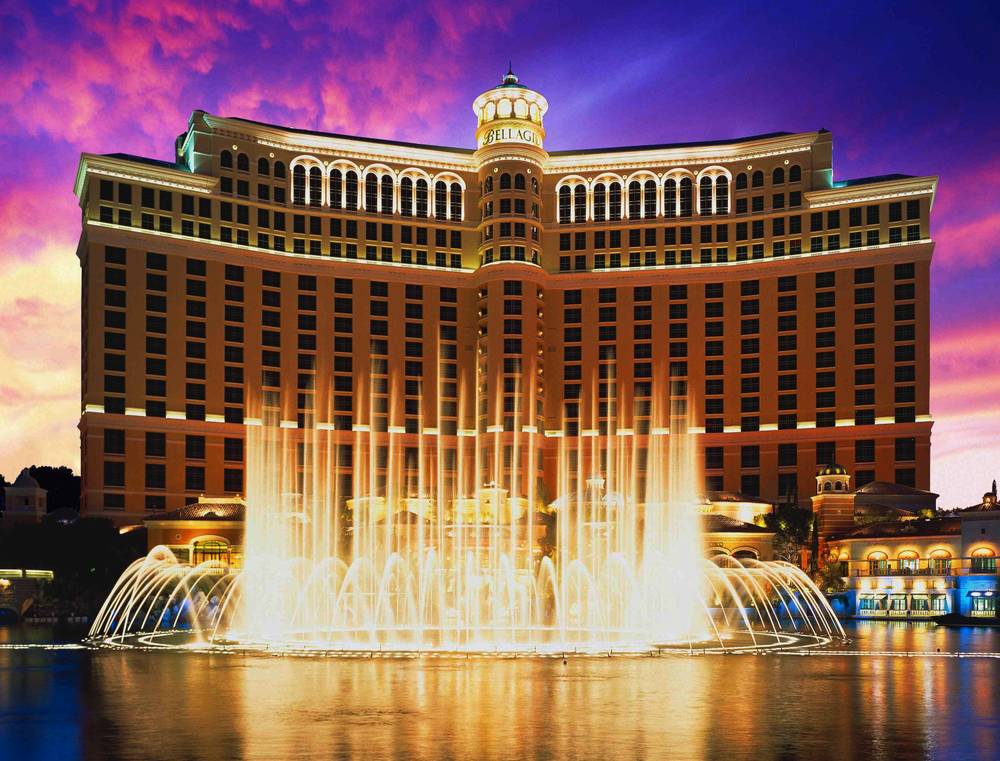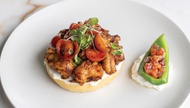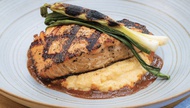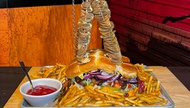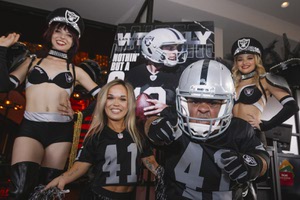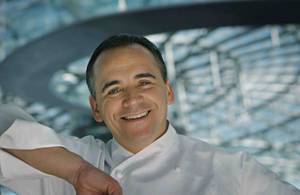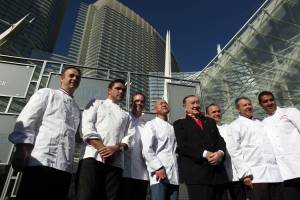Steve Wynn approached Jean-Georges Vongerichten in New York in April 1998 about opening a restaurant at his new Las Vegas resort, Bellagio. But the chef was busy.
“[Wynn] came for dinner one night saying, ‘Come to Vegas, come to Vegas. I’ll fly you in this weekend,’” recalls Vongerichten. “I couldn’t, because my parents were visiting for the next four days. They come see me once a year. But he said, ‘Bring them with you!’ So I took them. We flew over on his plane, in and out in 24 hours.”
It was the very first trip to Las Vegas for the acclaimed Alsatian chef, who was then operating New York restaurants Vong and JoJo. “We had a beautiful dinner at Mirage and then came over to Bellagio, still in construction, no water in the lake. [Wynn] said, ‘I want you to do one of two places, either the steakhouse by the water or a fish place, one or the other or both.’ I didn’t know how we were going to get fish here, so I figured we were closer to steak than the ocean.
“I didn’t know Las Vegas, but after I saw the whole vision of Bellagio, all I could think was, Oh my God, I want to be part of this.”
The deal was finished in 24 hours, including the name of the steakhouse—Prime—decided on the way back to the airport. It was a whirlwind adventure, perhaps fated. And his parents? “They thought it was nuts,” Vongerichten says. “Twenty-four hours in Vegas? They didn’t even know what happened.”
It wasn’t the first time one of Steve Wynn’s visions was called “nuts,” nor the first time an almost unbelievable concept became something legendary and essential on the Las Vegas Strip.
Bellagio opened on October 15, 1998. This month marks its 15th anniversary. Its presence at the heart of the Strip is so fundamental to our idea of Las Vegas that it seems as if the Lake Como-inspired luxury resort has simply always existed. Trip Advisor recently named the iconic dancing fountains the top landmark in the country, underscoring the already accepted belief that you can’t experience Vegas without it. From the fine art gallery to the ever-changing conservatory to the breathtaking Dale Chihuly installation above the lobby, everything about Bellagio changed the way hotels and casinos are conceived, assembled and appreciated.
Perhaps Bellagio’s most revolutionary and ambitious element was its food and beverage program. Wynn envisioned an all-star cast of the most talented culinarians in the country, working together to create previously unattainable levels of consistency, quality and service.
“What made it different is the way the [restaurant] deals were structured,” says restaurant consultant and developer Elizabeth Blau. “Other hotels were doing leases. This was comprehensive integration at every level.”
Blau had been working with Sirio Maccioni and negotiating the legendary restaurateur’s expansion to Las Vegas, where Maccioni’s Le Cirque and Osteria del Circo restaurants would be the foundation of Bellagio dining. Wynn stole Blau away during the process, and she teamed with Wolfgang Puck-alum Kevin Stuessi to fill out the restaurant roster.
“With each chef there was a management contract, which meant we took the best of what they had to offer and provided all ancillary services and support,” Blau explains. “The restaurateurs could focus on what they’re best at. And that contract became the prototype for every other contract used by Mirage Resorts and beyond.”
Gustav Mahler, then vice president of food and beverage at Mirage—which Wynn opened in 1989—created the master plan for Bellagio, sketching out restaurant placement and cuisine. Wynn’s longtime creative mastermind Roger Thomas selected interior designers for each project, and an experienced executive team—food and beverage leader Gamal Aziz and Bellagio president Bobby Baldwin—helped guide the plan into reality.
“[Baldwin] made sure our offices were next to him so he could be a mentor,” Blau says. “You can have a grand vision, but if it doesn’t work, where are you? Gamal is single-handedly responsible for making these great ideas happen, so he deserves the lion’s share of the credit.”
Together, the team sought out up-and-coming innovators, and the dynamic potential of the resort made it tough for chefs to say no. “All you had to do was start listening to Steve’s vision for the resort and walk around the building and see the magnitude, and you understood that everything had to be at that level,” Blau says.
With the fine French Le Cirque and whimsical Italian Circo already done deals, Blau and Stuessi went hunting. Todd English came to replicate his Mediterranean-influenced café, Olives, in the retail corridor. Michael Mina came from San Francisco to open a second seafood-focused Aqua (now known simply as Michael Mina) and Vongerichten added Prime, which opened with now-celebrity chefs Kerry Simon and Wylie Dufresne in the kitchen. For the signature experience at Picasso, a beautiful lakeside restaurant adorned with original art by its namesake master, a chef with a similar Spaniard-in-France background was chosen: Julian Serrano.
The standard of excellence applied to everything, from the buffet and 24-hour café to room service and the employee dining room. Jean-Philippe Maury, who had been named Meilleur Ouvrier (best pastry chef) in France in 1997, arrived as the resort’s executive pastry chef, and Grant MacPherson was lured from Singapore’s Raffles Hotel into the role of executive chef. “Everybody was working hard for the same goal, and everybody was overwhelmed,” remembers MacPherson. “It really took about 18 months to get things the way I wanted. Nobody had any clue how busy it was going to be and how to deal with that volume. It was a huge curve for everybody, but it was a great experience and I don’t think it could be repeated. It was a phenomenal time to be in Las Vegas.”
Fifteen years later, almost all the Bellagio restaurants are still operating in their original forms, each still among the best on the Strip. (A few exceptions: Shintaro transformed into Yellowtail, and Sam’s American became Nectar and then Fix. Sensi, the relaxing restaurant serving global cuisine, was part of the 2004 Spa Tower expansion.) In addition to gathering an unprecedented collection of nationally known chefs, Bellagio set a new standard in servicing the casino’s varied demographic needs through food. While the steakhouse and varied fine dining satisfied domestic table-game players, upscale Chinese restaurant Jasmine and casual Noodles catered to foreign visitors’ appetites. Today, the resort boasts three master sommeliers (among 100 across the entire country), and its culinary accolades include Michelin stars for Michael Mina and Le Cirque and two stars for Picasso.
Bellagio’s success provided massive exposure for everyone involved, boosting each chef’s reputation into the stratosphere. “If you look at Michael Mina’s career, and Todd English and even the Le Cirque group, everybody rolled into bigger, better things,” MacPherson says. “Look at what has happened with Jean-Philippe, opening there and at Aria. He changed pastry.”
Little has changed at most Bellagio restaurants over the years, a rare feat on the frantic Strip. A large percentage of opening staff members at Prime, Picasso, Jasmine, Le Cirque and Circo still work in those restaurants. Next year, two of the originals will finally transition when Circo closes and Olives becomes a new concept minus English, a sign of the times finally creeping into these timeless venues.
Still, more than 15 years after his whirlwind Vegas tour, Vongerichten has signed on for 15 more at Prime.
“I’ll be coming in with a cane,” he jokes. “Bellagio moved our company to the next level, for sure. A lot of people asked us to repeat Prime, but we did it exclusively for Bellagio, and we wouldn’t do it again. We’ve kept it very special.”
